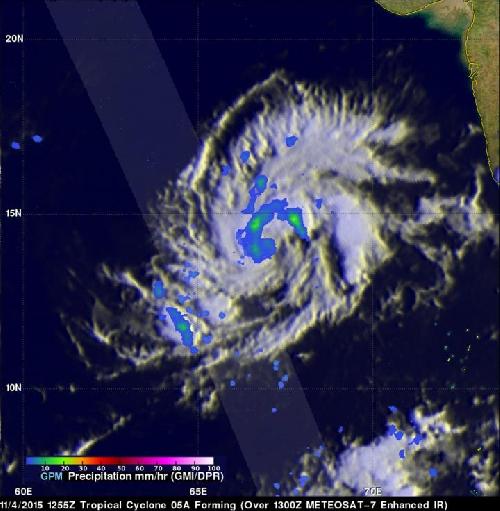NASA's Global Precipitation Measurement mission or GPM core satellite caught another tropical cyclone forming on Nov. 4, 2015 at 1255 UTC (7:55 a.m. EST) in the Arabian Sea.
Deadly tropical cyclone Chapala had just dissipated over Yemen when tropical cyclone 05A started forming in the warm waters of the Arabian Sea west of India. GPM measured the rainfall within the forming tropical cyclone using the satellite's Microwave Imager (GMI) and Dual-Frequency Precipitation Radar (DPR) instruments. GMI and DPR found that 05A had scattered light to moderate rainfall falling at a maximum rate of only 23.3 mm (.92 inches) per hour.
GPM is an international mission led by NASA and the Japan Aerospace Exploration Agency to observe rainfall and snowfall around the world. The program is managed by NASA's Goddard Space Flight Center in Greenbelt, Maryland.
 NASA/JAXA's GPM satellite measured scattered light to moderate rainfall in Tropical Cyclone 05A on Nov. 4, falling at a maximum rate of only 23.3 mm (.92 inches) per hour. Credit: Credits: NASA/JAXA/SSAI, Hal Pierce
NASA/JAXA's GPM satellite measured scattered light to moderate rainfall in Tropical Cyclone 05A on Nov. 4, falling at a maximum rate of only 23.3 mm (.92 inches) per hour. Credit: Credits: NASA/JAXA/SSAI, Hal Pierce
On November 5, 2015 at 1500 UTC (10 a.m. EST), Tropical Cyclone 05A was located near 13.9 degrees north latitude and 63.9 degrees east longitude, about 546 nautical miles (628.7 miles/ 1,012 km) east of Socotra Island, Yemen. Tropical Cyclone 05A is moving to the west at 10 knots (11.5 mph/18.5 kph). It is a tropical storm with maximum sustained winds near 35 knots (40 mph/64.8 kph).
The tropical storm is expected to track over the island of Socotra on Nov. 8 with tropical storm force winds while heading west.
The Joint Typhoon Warning Center (JTWC) predicts that 05A will head toward Cape Gardafui, Somalia, move into the Gulf of Aden and make landfall in southeastern Yemen north of Aden, Yemen on Nov. 10.
source: NASA/Goddard Space Flight Center